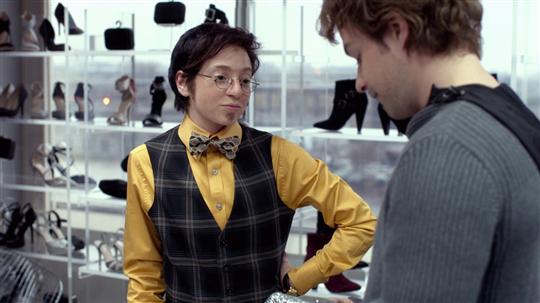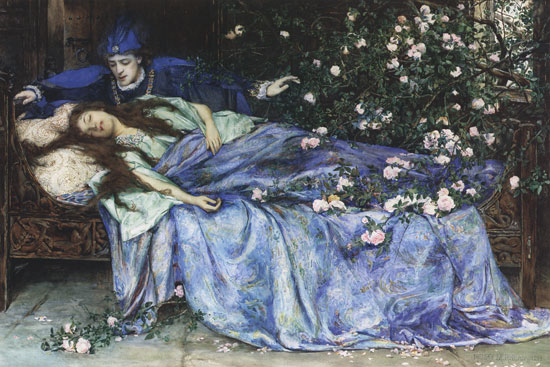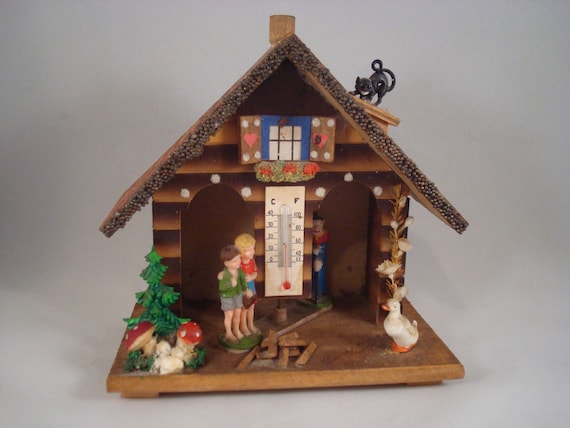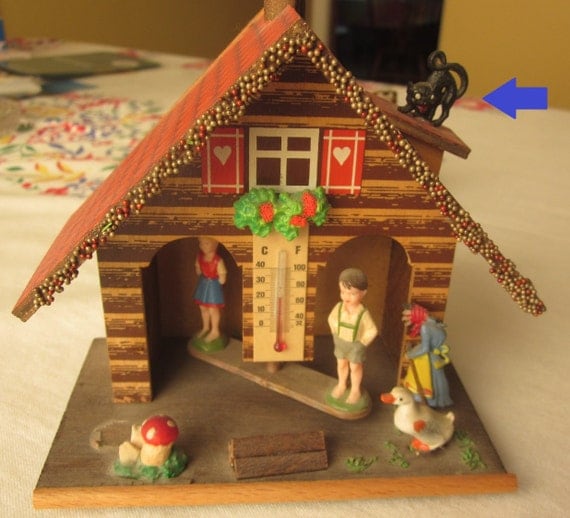This summer has been full of travels, weddings, and other such things that, while wonderful, make it a little harder for me to do the research and blog work I'd like. But I'm thrilled to be able to bring you some guests posts as I transition back into a regular school year routine! First up is Amy Elize Brown of
The Willow Web, although you may recognize her as the face behind the Blog Formerly Known As "Asleep in the Woods." I was so excited to find "Asleep in the Woods," which is where Amy shared some of the things she discovered as she was researching "Sleeping Beauty" for her dissertation! This Brit is very knowledgeable about fairy tales in general, and shares her insights with humor and personality, which makes her blog fun to read.
So as a special treat for Tales of Faerie readers, Amy has generously agreed to share with us 5 strange things she learned about Sleeping Beauty via her research!
******************************************************************
When studying fairy tales, there are always little things to notice. A golden goose in one
tale may be a swan in another, or you might find lots of enchanted necklaces. The fact that
the princess must visit the troll three times is significant, because it’s like the part in
another tale where another princess has to go to a ball three times…
The human brain loves to make patterns. Once you notice these details, you notice them
everywhere. When you choose a specific story to investigate, this only intensifies. For me,
this story was Sleeping Beauty and it’s variations, most notably
Sun, Moon and Talia
(Basile),
Little Briar-Rose (Grimm) and
The Sleeping Beauty in the Wood (Perrault). For
the year I spent working on my dissertation, my brain was a constant mush of spinning
wheels, cannibal ogres, and evil fairies/witches/wise women. I grew up with the
Disney version of Sleeping Beauty, which I still love, but I’ve always felt that it was somewhat…
lacking. Maleficent’s backstory and motive are never explained (well, not until the film
Maleficent was released in 2014, but even that doesn’t do a great job!), and poor Aurora
doesn’t get much choice in anything. She gets her happily ever after, but it could so easily
not have turned out like that. As a writing device, the premise of ‘girl cursed to fall asleep
for a century’ has so much potential. I wanted to use it.
Edmund Dulac
For my dissertation, I wrote the opening to a novel based on certain elements from
Sleeping Beauty. Specifically, I used "Sun, Moon and Talia" as my source. But before I got to
that final piece of writing, I researched Sleeping Beauty stories until I fell asleep at my
desk. Multiple times. I devoured and version of the story and every critical text about it that
I had time to, making notes on each to compare and contrast. Some things I learned were
exciting, and made me squeal about my own story and write faster. Some were obvious,
so I just glossed over them. Some were fascinating, and gave me a sense of the wider
context of the story. Others were just a bit strange. And come on, let’s be honest, it’s the
strange ones we’re really interested in, isn’t it?
Let me take you on a little tour into the strange side of Sleeping Beauty…
Strange Thing #1:
Not all spinning wheels have points… And ‘spindle’ is not another
word for spinning wheel
That iconic scene, where the princess touches the sharp point of the spinning wheel and
falls asleep? Not quite so easy to replicate in real life!
The sharp point of the spinning wheel is called the spindle. This is where the fleece (or
whatever you’re spinning) gets twisted to make it into yarn. The wheel is attached to the
spindle via a belt, and so when the wheel turns, it turns the spindle as well and that’s how
the fleece/whatever gets twisted into thread.
However, few spindles have the sharp metal point on them, and ever fewer have it
standing upright as shown in Sleeping Beauty. Most spindles are horizontal, and if they are
sharp they are protected by the other parts of the wheel to prevent spinners from injuring
themselves. Some spinning wheels have a vertical pole-type attachment called a distaff,
which is where the unspun fibres are stored to stop them from getting in the way. So it’s
more likely that the princess could prick her finger on that - except it’s not sharp!
1880s Oak Spinning Wheel
Spindles can also exist independently from spinning wheels - these are called drop spindles. A drop spindle is a straight spike, usually made from wood, with a round weight on the bottom which is called a whorl. Drop spindles come in different sizes, depending on how thick the spinner wants the yarn to be.
I actually bought a cheap second-hand spinning wheel to have a go with. Unfortunately,
the bolt through the centre of the wheel is lose so it doesn’t work properly. I’m still looking
for someone to fix it a year later. Spinning wheel repair people are few and far between!
However, I was recently given a drop spindle to play with, too. I’m still figuring that one out.
Strange Thing #2: How witches came to fly broomsticks
Not exactly Sleeping Beauty related, but this is one of the most peculiar and fascinating
things I came across on my dissertation journey.
Every Halloween, we are inundated with images of women wearing pointy hats and flying
on broomsticks. Magic, right? Actually, the reality is quite different…
Flying ointment. Not something made up of sugar, spice, and all things nice, that’s for sure!
Flying ointment was composed of herbs such as henbane, belladonna, hemlock, and
wolfsbane. If ingested, these are poisonous. But if heated to extract the oil and then mixed
with animal fat, they become hallucinogenic. This mixture was absorbed through the skin
(and… other places. Just look at the shape of a broom, doesn’t take much imagination!),
and used before mounting broomsticks to simulate flying through hallucination.
Due to the toxicity of the herbs, to prevent the flying ointment from causing harm opium
was used as an antidote. Opium’s properties oppose belladonna’s, and so taking it
counteracts the effects of the poison. A variation of flying ointment including morphine and
opium was also given to women during childbirth, to ease pain and encourage temporary
amnesia.
Another version of flying ointment is the mould ergot, which grows on rye bread. Again, if
ingested in large quantities it is lethal, but smaller amounts absorbed through the skin and
‘other places’ produce hallucinogenic effects.
I’m going to link you to
Kristin’s post about drug use in fairy tales for more information and
links about this topic. When I was doing my research, that was what led me to this topic!
Strange Thing #3: It’s not just princesses who sleep… there’s also a
fairy tale about a sleeping prince!
Funnily enough, it’s called ‘The Sleeping Prince.’ And it does exactly what it says on the
tin! Although, as well a being a gender-bent version of Sleeping Beauty, it also contains
elements of Snow White and East of the Sun, West of the Moon.
A princess is sewing, and she pricks her finger and spills droplets of blood onto the
windowsill. This happens three times, and each time a bird appears. The bird tells the
princess about a prince who is asleep, and will awaken on St. John’s night. So the
princess sets out to find him, wearing a pair of iron shoes because the journey is long and
tough.
She meets three old women, whose sons are the winds. They give her directions to the
prince’s castle. When she arrives there, she waits until the prince awakens and then they
get married.
You can read the full story
here
Strange Thing #4: Fairies, witches, and wise women can be interchangeable.

Depending on the version of the story, the beings which bestow gifts on the princess vary.
It can be fairies, goddesses, or wise women. But ultimately, these are all variations on a
theme. They are ambiguous, and magical. Many folklorists draw parallels between
witches, fairies and goddesses from ancient mythology. Over time, they have evolved to
become interchangeable terms for one another. Interesting, because in some cases this
undermines the true natures and histories of witches, fairies, and goddesses, but in others
it reinforces the sense of shared roots between the three entities. In "Sun, Moon and Talia",
goddesses are present at the christening. In "The Sleeping Beauty in the Wood", it's fairies.
In "Little Briar-Rose", it’s wise women - which seems to be a more polite way of saying
‘witch.’ Being a wise woman would still have earned you a trip to the stake during the times
of the witch trials.
For further reading, I recommend Jack Zipe’s book
The Irresistible Fairy Tale: The Cultural and Social History of a Genre. There is a whole chapter in here about witches, fairies and
interchangeability.
Strange Thing #5: The moral of the story
Like all fairy tales, Sleeping Beauty has been interpreted in lots of different ways by lots of
different people. Most commonly, it is seen as a story of warning against parents who try to
prevent their children (particularly daughters) from reaching sexual maturity. Regardless of
the king’s efforts, the princess pricks her finger on the spinning wheel anyway. Growing up,
menstruation, and sex are inevitable rites of passage, and if parents interfere then they
may cause more harm than good. Like, a 100 years worth of sleep type of harm…
Henry Meynell Rheam
However, Charles Perrault offers another moral to the end of "The Sleeping Beauty in the
Wood":
‘Many a girl has waited long
For a husband brave or strong;
But I'm sure I never met
Any sort of woman yet
Who could wait a hundred years,
Free from fretting, free from fears.
Now, our story seems to show
That a century or so,
Late or early, matters not;
True love comes by fairy-lot.
Some old folk will even say
It grows better by delay.
Yet this good advice, I fear,
Helps us neither there nor here.
Though philosophers may prate
How much wiser 'tis to wait,
Maids will be a-sighing still --
Young blood must when young blood will!’
This poem varies from translation to translation, but the meaning remains the same.
Patience is a virtue. If you wait for love, it will be just as good or perhaps better than if you
rush into things. When the princess pricks her finger, she is not ready for commitment. Her
long sleep is symbolic of waiting until she is ready to receive the prince’s affection. But
many young women are impatient, and although he advises them to wait Perrault cannot
quite bring himself to condemn them with his moral- ‘young blood must when young blood
will.’ Although,
In The Uses of Enchantment, Bettelheim says that 'to have to wait even a long time for sexual fulfilment does not at all detract from its beauty' (p231).
You can read more about my research on
The Willow Web, under the label ‘
dissertation.’
*********************************************
Thanks for sharing, Amy! I've loved having this fun peek into your research! There's a lot more where this came from if you're interested in her posts on
fairy tales or want to read more about her
Sleeping Beauty research, just follow the tags!












